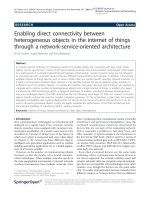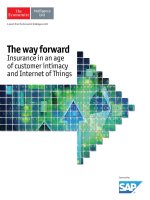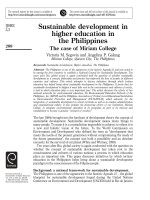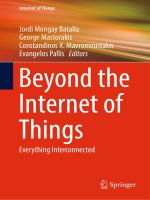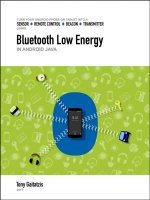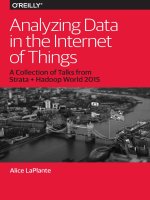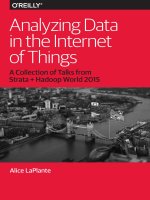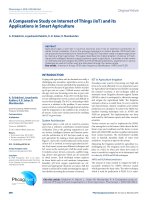higher nationals in computing unit 43 internet of things
Bạn đang xem bản rút gọn của tài liệu. Xem và tải ngay bản đầy đủ của tài liệu tại đây (3.25 MB, 37 trang )
<span class="text_page_counter">Trang 2</span><div class="page_container" data-page="2">
<b>Higher Nationals in Computing</b>
<b>Unit 43: Internet Of ThingsASSIGNMENT 1</b>
Learner’s name: Tran Ngoc ChauID:GCS18804
Class: GCS0805BSubject code: 1690
<b>Assessor name: PHAN MINH TAM</b>
</div><span class="text_page_counter">Trang 3</span><div class="page_container" data-page="3">ASSIGNMENT 1 FRONT SHEET
Qualification BTEC Level 5 HND Diploma in ComputingUnit number and title Unit 43: Internet of Things
</div><span class="text_page_counter">Trang 4</span><div class="page_container" data-page="4">❒Summative Feedback: ❒Resubmission Feedback:
Signature & Date:
</div><span class="text_page_counter">Trang 5</span><div class="page_container" data-page="5"><b>IV name and date</b>
<b>Submission Format:</b>
This assignment is an and specifically including
You must use font Calibri size 12, set number of the pages and use multiple line spacing at1.3. Margins must be: left: 1.25 cm; right: 1 cm; top: 1 cm and bottom: 1 cm. The referencefollows Harvard referencing system. The recommended word limit is 2.000-2.500 words.You will not be penalized for exceeding the total word limit. The cover page of the reporthas to be the Assignment front sheet 1.
Submission Students are compulsory to submit the assignment in due date and in a way requested by the Tutors. The form of submission will be a soft copy posted on
Note: The Assignment must be your own work, and not copied by or from another student or frombooks etc. If you use ideas, quotes or data (such as diagrams) from books, journals or other sources, youmust reference your sources, using the Harvard style. Make sure that you know how to referenceproperly, and that understand the guidelines on plagiarism. If you do not, you definitely get fail
<b>Unit Learning Outcomes:</b>
<b>LO1 Analyse what aspects of IoT are necessary and appropriate when designing software applicationsLO2 Outline a plan for an appropriate IoT application using common architecture, frameworks, tools, hardware</b>
and APIs
</div><span class="text_page_counter">Trang 6</span><div class="page_container" data-page="6"><b>LO4 Evaluate your IoT application and detail the problem your IoT application solves, the potential impact on</b>
people, business, society and the end user and the problems it might encounter when integrating into the widerIoT ecosystem
<b>Assignment Brief and Guidance:</b>
You currently work as a product developer for a new startup where you design IoT products for theconsumer, corporate, government and defence clients. As part of your role your manager has tasked youto plan and develop a new IoT product, service or application for a potential client. You are required toidentify a target user and conduct tests with this user and include this feedback into multiple iterativeversions of your product.
<b>Part 1 (Assignment 1):: For the first part, you must:</b>
Plan an IoT application for a specific target end user and the tests you intend to conduct with thisuser. This plan will be in the form of a document and will include supporting evidence andmaterial, such as user personas and customer journey maps.
Create multiple iterations of your application and modify each iteration with enhancementsgathered from user feedback and experimentation. This will follow the pathway outlined in yourplan.(log book,)
<b>Part 2 (Assignment 2): For the first part, you must:</b>
Show evidence about Developed IoT application using any combination of hardware, software,data, platforms and services (video or images of your IoT system with code snippet)
Evaluate your IoT application and detail the problem your IoT application solves, the potentialimpact on people, business, society and the end user and the problems it might encounter whenintegrating into the wider IoT ecosystem
</div><span class="text_page_counter">Trang 7</span><div class="page_container" data-page="7">Pass Merit Distinction
<small>LO1 Analyse what aspects of IoT are necessary and appropriate when designing software applications</small>
<small>P1 Explore various forms of IoT functionality.</small>
<small>P2 Review standard architecture, frameworks, tools, hardware and APIs available for use in IoT development.</small>
<small>M1 Evaluate the impact of common IoT architecture, frameworks, tools, hardware and APIs in the software development lifecycle.</small>
<small>M2 Review specific forms of IoT architecture, frameworks, tools, </small>
<small>problem-solving requirements.</small>
<small>D1 Evaluate specific forms of IoT architecture and justify their use when designing software applications.</small>
<small>LO2 Outline a plan for an appropriate IoT application using common architecture, frameworks, tools, hardware and APIs</small>
<small>P3 Investigate architecture, frameworks, tools, hardware and API techniques available to develop IoT applications.</small>
<small>P4 Determine a specific problem to solve using IoT.</small>
<small>M3 Select the most appropriate IoT architecture, frameworks, tools, hardware and API techniques to include in an application to solve this problem.</small>
<small>M4 Apply your selected techniques to create an IoT application development plan.</small>
<small>D2 Make multiple iterations planof your IoT application and modify each iteration to improveyour IoT application security.</small>
</div><span class="text_page_counter">Trang 8</span><div class="page_container" data-page="8"><b>Table of Contents</b>
Unit 43: Internet Of Things ASSIGNMENT 1...1
LO1 Analyse what aspects of IoT are necessary and appropriate when designing software applications...1
P1 Explore various forms of IoT functionality...1
What is IoT... 1
Features of Internet of Things (IoT)...1
IoT history... 3
The various forms of IoT...6
IoT in software development...11
Advantanges and Disadvantanges of Using IoT...11
P2 Review standard architecture, frameworks, tools, hardware and APIs available for use in IoT development + P3 Investigate architecture, frameworks, tools, hardware and API techniques available to develop IoT applications... 12
Figure 2: IoT History... 6
Figure 3: Internet of Underwater Things (IoUT)...7
</div><span class="text_page_counter">Trang 9</span><div class="page_container" data-page="9">Figure 5: Internet of battlefield things (IoBT)...8
Figure 6: Internet of Space Things (IoST)...9
Figure 7: Internet of NanoThings (IoNT)...10
Figure 8: Internet of Bio-Nano Things (IoBNT)...10
Figure 9: IoT architecture... 13
Figure 10: Perception Layer... 13
Figure 11: Network Layer...14
Figure 12: Application Layer...14
Figure 13: Device Hardware... 15
Figure 14: Device Software... 16
Figure 15: Communication and Cloud Platform...16
Figure 16: Cloud Application... 17
</div><span class="text_page_counter">Trang 10</span><div class="page_container" data-page="10"><b>Figure 1: IoTFeatures of Internet of Things (IoT)</b>
- The most crucial element to consider in the case of IoT is connection. It is impossible to perform any
</div><span class="text_page_counter">Trang 11</span><div class="page_container" data-page="11">the IoT ecosystems (sensors, compute engines, data hubs, and so on). Radio waves, Bluetooth, Wi-Fi, Li-Fi, and other technologies can be used to link IoT devices. In order to improve efficiency and build generic communication across IoT ecosystems and industry, we may use several protocols of internet connectivity layers. In certain situations, the IoT ecosystem may be created on-premises or within an intranet.
- We humans have a natural ability to comprehend and assess our surroundings based on our previousencounters with various objects or situations. To get the most out of IoT, we need to read the analog data and transform it in a way that allows us to draw useful insights from it. To collect data depending on a specific problem, we employ Electrochemical, gyroscope, pressure, light sensors, GPS, Electrochemical, pressure, RFID, and so on. Light detection sensors, as well as pressure, velocity, and imaging sensors, are used in automobile applications. We must select the appropriate sensing paradigm to make a use case successful.
- Security is one of the most important aspects of the IoT ecosystem. Sensitive data is transmitted from endpoints to the analytics layer via connection components throughout the whole cycle of an IoTecosystem. To protect data from misuse and manipulation, we must adhere to adequate safety, security measures, and firewalls while developing an IoT system. Any component of an IoT ecosystem that is compromised might eventually cause the entire pipeline to collapse.
- Data is utilized to create key business insights and drive crucial business choices in nearly every IoT use case in today's world. On top of this huge data, we build machine learning/deep learning models to gain important insights. The analog signals are preprocessed and transformed to a format that may be used to train machine-learning models. We must consider the appropriate data infrastructure depending on business requirements.
<b>Dynamic Nature</b>
- The first and most important step in every IoT use case is to gather and transform data in a fashion
</div><span class="text_page_counter">Trang 12</span><div class="page_container" data-page="12">must alter their states on a regular basis. A temperature sensor's input, for example, will change over time depending on weather conditions, location, and other factors. This is something that IoT devices should be developed with in mind.
- IoT devices should be built in a way that allows them to be readily scaled up or down on demand. IoTis being utilized in a wide range of applications, from smart home automation to automating big factories and workstations, thus the use cases are diverse. A carrier's IoT infrastructure should be based on their present and future engagement scale.
- 1990: In answer to a challenge, John Romkey connected a toaster to the Internet and successfully turned it on and off, bringing us even closer to what we consider modern IoT devices.
- 1993: Engineers from the University of Cambridge design a system that captures three photos of a coffee machine every minute, allowing its status to be remotely monitored by workers, continuing the already well-established practice of connecting the Internet with appliances and food. The first webcam in the world!
- 1995: The first version of the US government's long-running GPS satellite program has finally been
</div><span class="text_page_counter">Trang 13</span><div class="page_container" data-page="13">IoT devices: position.
- 1998: IPv6 is designated as a draft standard, allowing more devices to connect to the internet than IPv4. While 32-bit IPv4 only has enough unique identifiers for about 4.3 billion devices, 128-bit IPv6 has enough for up to 2128, or 340 undecillion devices. (That's 340 followed by 36 zeros!)
- 1999: This is a significant year for IoT since it is when the term was most likely coined. It was used in a presentation to Proctor & Gamble executives by Kevin Ashton, the leader of MIT's Auto-ID laboratories, to demonstrate the possibilities of RFID tracking technology.
- 2000: LG introduces the Internet refrigerator, which has quickly become a must-have IoT item. It was an intriguing concept, replete with displays and monitors to help you keep track of what was in your refrigerator, but its $20,000+ USD price tag didn't win it many fans.
- 2004: The phrase "Internet of Things" begins to emerge in book titles and in other media outlets.
- 2007: The first iPhone is released, introducing a completely new way for people to engage with the world and Internet-connected gadgets.
- 2008: Zurich, Switzerland hosts the first worldwide Internet of Things conference. The year is significant because it marks the first time that the number of Internet-connected devices has surpassed the number of people on the planet.
- 2009: St. Jude Medical Center launches Internet-connected pacemakers, while Google begins driving car experiments. St. Jude's gadget would go on to create even more history in 2016 by becoming the first IoT medical equipment to be hacked (without casualties, fortunately). Also, Bitcoin becomes live, paving the way for blockchain technologies, which are expected to play a significant rolein IoT.
self-- 2010: The Chinese government has identified IoT as a critical technology and stated that it would be included in their long-term growth strategy. Nest develops a smart thermostat the same year that learns your behaviors and automatically changes your house's temperature, placing the "smart home" idea in the limelight.
- 2011: Gartner, a market research organization, has added IoT to their "hype cycle," a graph that
</div><span class="text_page_counter">Trang 14</span><div class="page_container" data-page="14">crest of inflated expectations, and it appeared like it was on its way to a reality check in the trough of disappointment before reaching the productivity plateau.
- 2013: Google Glass is introduced, marking a watershed moment in IoT and wearable technology, albeit it may be ahead of its time. It lands with a thud.
- 2014: The launch of Amazon's Echo has paved the stage for a rush into the smart home hub market. In other news, an Industrial IoT standards collaboration has formed, demonstrating how IoT has the ability to transform a variety of industrial and supply chain operations.
- 2016: General Motors, Lyft, Tesla, and Uber are all experimenting with self-driving cars. Unfortunately, the first large-scale IoT malware attack has been verified, with the Mirai botnet infecting IoT devices using factory-default logins, seizing control of them, and utilizing them to DDoS major websites.
-2017-2019: IoT development is becoming more affordable, simple, and widely accepted, resulting in tiny waves of innovation across the sector. Self-driving vehicles are becoming better, blockchains and AI are starting to find their way into IoT systems, and growing smartphone/broadband adoption is making IoT an even more appealing prospect for the future.
</div><span class="text_page_counter">Trang 15</span><div class="page_container" data-page="15"><b>The various forms of IoT1. Internet of underwater things</b>
- Following the popularity of the Internet of Things (IoT), the Internet of Underwater Things (IoUT) wasinitially suggested in 2012. The application of IoT to our water bodies is known as IoUT. Underwater, the Internet of Things (IoUT) is a network of interconnected smart devices. The goal of this technology
</div><span class="text_page_counter">Trang 16</span><div class="page_container" data-page="16"><b>Figure 3: Internet of Underwater Things (IoUT)2. Internet of underground things</b>
- The Internet Of Underground Things (IOUT), which is made up of sensors and communication devicesplaced partially or entirely underground for real-time soil sensing and monitoring, was born out of this requirement. The seamless integration of subterranean sensors, machinery, and irrigation systems with the complex social network of producers, agronomists, crop consultants, and advisers is made possible by this new paradigm.
</div><span class="text_page_counter">Trang 17</span><div class="page_container" data-page="17"><b>3. Internet of battlefield things</b>
- Due to battlefield-specific problems such as the lack of communication infrastructure and the susceptibility of devices to cyber and physical assaults, Internet of battlefield things (IoBT) networks differ considerably from typical IoT networks. Real-time data gathering, which is dependent on network connectivity and information dissemination in the presence of enemies, is critical for combat efficiency and coordinated decision-making in war scenarios. The goal of this project is to provide theoretical foundations for constructing safe and reconfigurable IoBT networks.
<b>Figure 5: Internet of battlefield things (IoBT)</b>
</div><span class="text_page_counter">Trang 18</span><div class="page_container" data-page="18">- The Internet of Space Things (IoST) is a cyber-physical system that combines on-the-ground data withsatellite data to allow a variety of applications. To operate and manage a system of tiny satellites (CubeSats) and ground-based sensing devices, the space-based network uses software-defined networking (SDN) and network function virtualization (NFV).
<b>Figure 6: Internet of Space Things (IoST)</b>
<b>5. Internet of nanothings</b>
- The Internet of NanoThings (IoNT) is a network of nanoscale devices that are linked together. Despitebeing a useful tool for a variety of purposes, the artificial nature of IoNT devices might be harmful in situations when the deployment of NanoThings has unintended consequences for health or pollution.
</div><span class="text_page_counter">Trang 19</span><div class="page_container" data-page="19"><b>6. Internet of bio-nanothings</b>
- The Internet of Bio-Nano Things (IoBNT) is a realm in which biological processes within the human body interact with the internet's cyber environment. The IoBNT paradigm, which is based on synthetic biology and nanotechnology technologies, allows for the creation of biological embedded computer devices known as nano-machines.
<b>Figure 8: Internet of Bio-Nano Things (IoBNT)</b>
</div>
